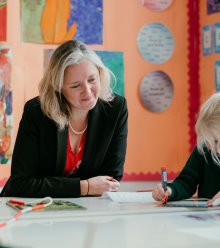Head of School Newsletter Nº2 Editorial | How our guiding statements and our philosophy is shaping our remote learning programmes

There were two small boys, John and Jim, who were friends. Jim had a dog.
One day they were taking the dog for a walk and Jim said proudly, “I’ve taught the dog to whistle”
“What do you mean?”, said John “He’s not whistling”.
“I know”, said Jim
“but I said I’d taught him to whistle not that he’d learnt”
(Extract from ‘This much I know about love over fear...creating a culture for truly great teaching. John Tomsett 2017)
Schools are about learning. It is their daily business. Their bread and butter. The thing that they exist for. But what does ‘learning’ mean, and how can schools ensure that it happens - whether or not the school gates are open?
At St Julian’s we have developed a set of 10 key areas that we believe are the essential ingredients in ensuring that learning happens - our ‘Learning Essentials’. We use these to guide our practice in the classroom, to provide professional development opportunities for our teachers, to develop ways to evaluate the learning taking place in the classroom and to focus our conversations on what makes good learning.
In the first of our new Keeper’s Pod Podcast series the Leadership team will talk about what they feel is important in developing high quality learning experiences for all.
For me, one of the most important of our learning essentials is that students are learning though having high quality teacher-student relationships. This is an area that has been demonstrated in one of the most pivotal pieces of research in recent educational times carried out by John Hattie, a researcher from New Zealand and Professor of Education and Director of the Melbourne Education Research Institute. Hattie and his team carried out a meta-analysis of educational research around the world looking at the factors that have the highest impact on student educational outcomes - he called the effect that these factors have the ‘effect size’. When I read this research in one of his early books, “Visible Learning: a synthesis of over 800 meta-analyses relating to achievement” (Hattie, 2009), the fact that teacher-student relationships had a very high effect size came as no surprise - certainly from the work that I have done in my career working with students and teachers this is one of the areas that students consistently report having a positive impact on them.
The challenge for any school, and for St Julian’s, during this period of learning away from school has been to maintain and continue to develop these relationships with students despite not being in the same room, or even country as them. We have focused on doing this through the use of interactions with students using the Google for Education suite - Meets, Hangouts and Chats - in small groups, class groups and tutor groups.
What has been important for us though has been to ensure that we balance the time spent interacting with students through methods that can lead to relatively passive learning through listening to a teacher speak, to a whole range of methods that engage students in constructing meaning for themselves. Seeing that learning has created meaning for a student - those amazing light-bulb moments - are goosebump moments for teachers: when you can see, or hear, or read that a student not only understands a concept but has taken it to the next level and is using higher order thinking skills such as analysis, evaluation and creation. When learning is going well this is the type of thinking that should and will be happening - the type of learning that will make lasting connections in our brains and the type of learning that will stick. Some simple examples of where we’ve seen this recently are a science teacher asking Year 8 students to experiment with using alcohol gel on their hands and to think, using their knowledge of particle theory, what the sensation that it gives tells allows them to analyse or conclude about the process that is happening when the gel evaporates. Simple activities like this can be the ones that we remember for a long time - ask your Year 8 child why your hands feel colder after you’ve used alcohol gel!
Using a constructivist approach to learning has been talked about for almost half a century decades, but when it is interwoven with quality strategies related to assessment and feedback and combined with great teacher-student relationships is when the magic happens.
That is what we are trying to create all of the time. Even in COVID-19 times.
In our next series of editorials and podcasts we will delve deeper into why we feel that our St Julian’s Learning Essentials are pivotal in ensuring that high quality learning happens.
Learning at St Julian’s School
St Julian’s School has 10 Learning Essentials that guide the practice in the classroom. The St Julian’s learning Essentials describe how students are developing the St Julian’s values of respect, independence, responsibility, commitment and honesty, in addition to the IB Learner Profile, through their learning.
At St Julian’s all students are:
- Learning through having high quality teacher-student relationships
- Confident, safe and enjoy their learning in a stimulating environment
- Learning collaboratively and independently
- Learning through enquiry and constructing meaning for themselves
- Challenged and supported in their learning (low threshold, high ceiling)
- Understanding how well they are doing and what the next steps are
- Reflecting on their learning and how they learn (through guided opportunities and constructive feedback)
- Developing skills, knowledge and understanding
- Understanding what they are learning and why (the ‘big picture’)
- Taking risks in their learning and feel comfortable to make mistakesEnter your news text here using the editor above to adjust formatting.


















.png&command_2=resize&height_2=85)











